An Expert Guide on Using Drone Photography for Realtors
When you book any photography package with us, you have the option to add aerial photos. We even offer a “light aerial” package if you just need a handful of drone shots. A common question we get is “When should I order drone photos?”
Sometimes, the answer is obvious. If your listing is perched on multiple acres, aerial is going to be the only option to get the entire parcel in frame and really give buyers an idea of what they are looking at. Likewise, if you’re listing a condo in a high rise in Royal Oak or a Detroit loft, you’ll probably want to upgrade to a drone package to get some eye-catching exteriors of the building and to show off any balconies or roof top amenities.
Aerial image from a listing at 350 N. Main Street in Royal Oak.
But here’s a secret: often the best drone photos don’t seem like they were taken with a drone at all! The point of a drone isn’t just to get a view from the highest vantage point possible. You’ll often see less experienced drone photographers getting lots of roof-down shots. One or two top-down “google earth” style shots is fine to show a parcel, but you’re selling a house, not a roof. Oftentimes just getting a camera 15-25 feet in the air offers a perspective that is much more pleasing to the eye and it will help your listing stand out from a sea of thumbnails on the MLS or Zillow.
The real point of drone photography is getting a camera in a position that would be impossible otherwise.
Let’s start with the money shot: the front exterior. Everyone needs a great, compelling front exterior for the MLS. The very best vantage point for a front exterior photo is at the exact center point of the house. Look at the example below. In an ideal world, we would always place our camera so that it’s centered both left-to-right, but also top-to-bottom with the house. That’s the sweet spot for getting the most ideal image with the proper perspective and no distortion. When you see beautiful architectural renderings, you’re seeing a house from this perspective.
For the average ranch or even mid-sized colonial, we can accomplish this (or get close enough to it) using our tripods. But for larger homes, it can be difficult or even impossible to get our cameras high enough. Photos taken from the ground can still look good, but if you’re looking for that extra oomph to set your listing apart from the rest, a drone can help.
The Taller the House, The More You Need Drone
If your listing has a soaring elevation – like a two-story new construction home with 9-foot or higher ceilings, or a home with a third floor, adding drone photos is practically a must. With homes this tall, to reach that sweet spot I mentioned above, our camera needs wings.
Likewise, if the home is perched on a hill, or is built on a steep foundation where there is a half flight of stairs to get to the front door, drone is a good idea. You see this a lot with new construction, particularly with townhouse type homes. (Condos that are built with the living space over the garage are almost always a good candidate for aerial photos.)
Between the short flight of stairs to the porch and the finished third floor, this tall colonial really benefits from drone photography. And note that this image doesn’t scream “drone”.
Sometimes it can be hard to visualize the impact drone can have this kind of standard front exterior, so let’s compare a drone shot vs. a ground shot.
Here the difference is pretty dramatic, getting the camera up higher helped center the house in the frame, eliminating a lot of the lawn in the foreground and effectively making the house appear much larger. When buyers are looking online at tiny thumbnail images deciding which listing to click on, which do you think as more impact?
This example is on one side of the spectrum, so let’s look at a more subtle example. Here both homes fill the frame equally, but there are clues as to which one was shot with a drone and which was shot with a tripod. Can you see the difference?
Drone shot on left, tripod shot on right.
The drone shot makes the home look more balanced, you can see the upper part of the house better without the overhang impeding the view of the second floor. The ground shot, while still a perfectly fine shot, shows the ceiling of the overhang and cuts into one of the windows on the second floor. There can be some subjectivity here as to which look you prefer, but personally, I think the drone shot looks better.
Need to minimize the front yard? Drone is your friend.
Let’s say you’re listing a new construction home before the landscaping is done. Or maybe the lawn is yellow and dead in the middle of summer. Or it’s winter and the front yard just isn’t looking the best and nothing can be done when it’s freezing outside. You may think adding drone would be the LAST thing you’d want to do, after all, who would want more photos of a bad looking yard? But actually, getting the camera off the ground allows us to eliminate a lot of yard that would otherwise take up a large percentage of the foreground. One of our photographers was recently sent to a listing just like that, and decided to pop her drone up just to show him what was possible.
In the words of the agent “I was today years old when I realized that pictures that look like that are actually taken with a drone”.
Drone isn’t just handy to shift attention away from front yard that doesn't have a lot of curb appeal. It can also be used to draw emphasis to a BACK yard, even on a front exterior shot. Sounds like magic, doesn’t it? This brings me to my next point…
Waterfront Homes Deserve Drone Photography
Another time where drone is a must-have addition to your package is when your listing sits on a lake, canal, or even has a large pond on the property. The elevation of a drone shot allows us to show off that lake frontage even on the front exterior photo. (And this rule applies even if it’s not to show off a body of water, maybe your listing backs up to mature woods, or a state park. Here in Michigan we are blessed with an abundance of lakes, so waterfront is the example that comes first to mind.)
Here’s another great example. Compare the two shots below – the one on the left is what our photographer could capture from the ground with a tripod. The second shot is what she was able to get with her drone. HUGE difference.
Tripod shot vs. the drone shot.
What surprised me when I put these examples side by side is that these images also make a compelling case for using drone with sprawling ranches. A low-slung ranch is not an obvious candidate for drone photography. When it’s on the smaller side, a ground level exterior is usually sufficient and I’d probably advise you to save your money and just book a traditional photo package. But when you have a long, large ranch like this, you can see that in order to frame the house from the ground, our photographer had get back pretty far – which means there was a lot of foreground in this photo. And because it was mostly concrete, it’s not the most attractive view. In the aerial view, our photographer was able to show off the lake view, AND frame the house in a much more appealing way that cropped off a lot of that concrete.
But forget the lake for a second. Notice how much more dimension and shape you can see in the aerial shot, particularly in the roof. Because the tops of the windows end directly under the roof line, this house looks a bit flat and compressed from the ground photo. The downward view of the aerial shot makes the lack of space between the windows and roof line less obvious, effectively making the house feel bigger. The windows also look more prominent because less of the bushes are covering them up from a higher angle. This house has a profile that honestly looks the best from an elevated perspective.
I mean, this almost looks like two different houses, doesn’t it?
The drone photo is also giving us a LOT more information, and that’s something buyers always appreciate. We always consider it part of our job as real estate photographers to visually provide as much information as possible to the buyer. Everyone looks at the photos first before they decide to even read the rest of the listing info, much less set up a showing. The more info you can convey in an image about location, layout, or amenities, the better. All we know from the ground level photo is that there is a lot of driveway in front of this house. That’s about it. The aerial photo still shows us there’s a big circle driveway, but the driveway is not taking up half the image. Instead we are telling the buyer about the lakeside location, the views in the backyard, and how big the home is by showing the bump outs in the rear of the house.
Drone images also allow us to get out over the water to get a perspective that would be difficult to get otherwise, like the examples below show. Notice again how it’s not always about getting the highest perspective possible. In fact, for waterfront images, getting the camera low out over the water often creates a very pleasing image, specially of docks, boathouses, etc. Capturing images from a variety of vantage points also adds visual interest to your listings (and your social media posts.)
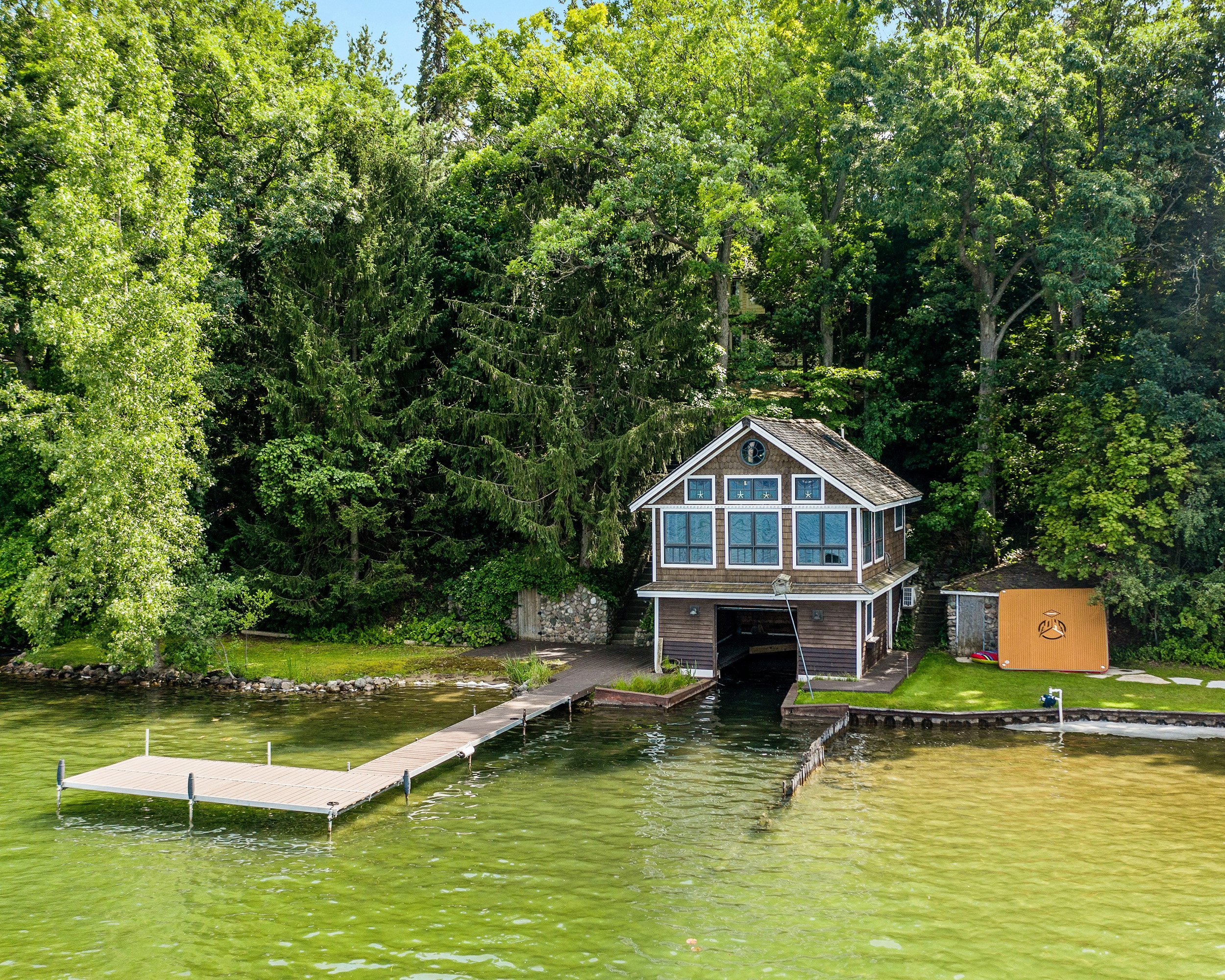
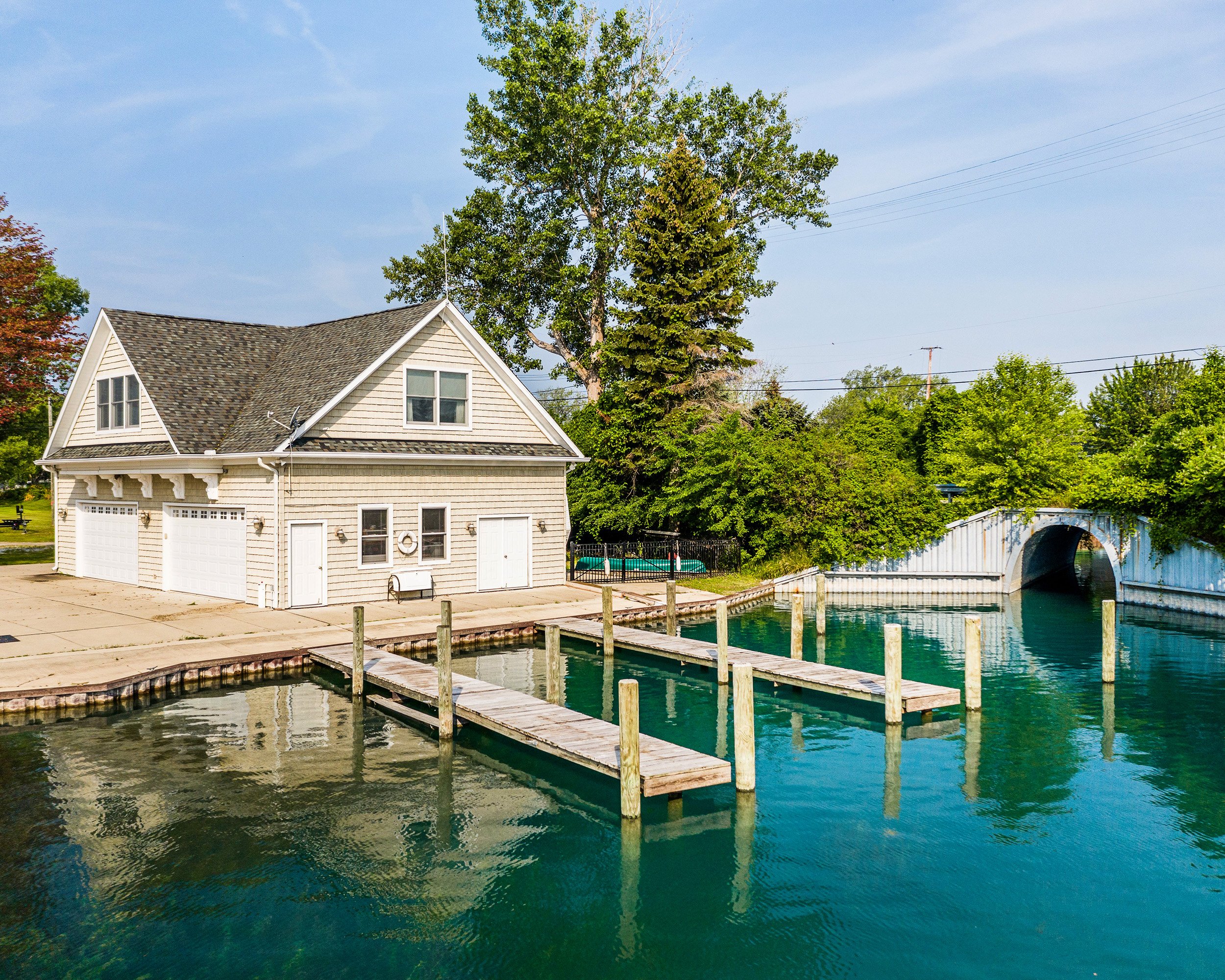
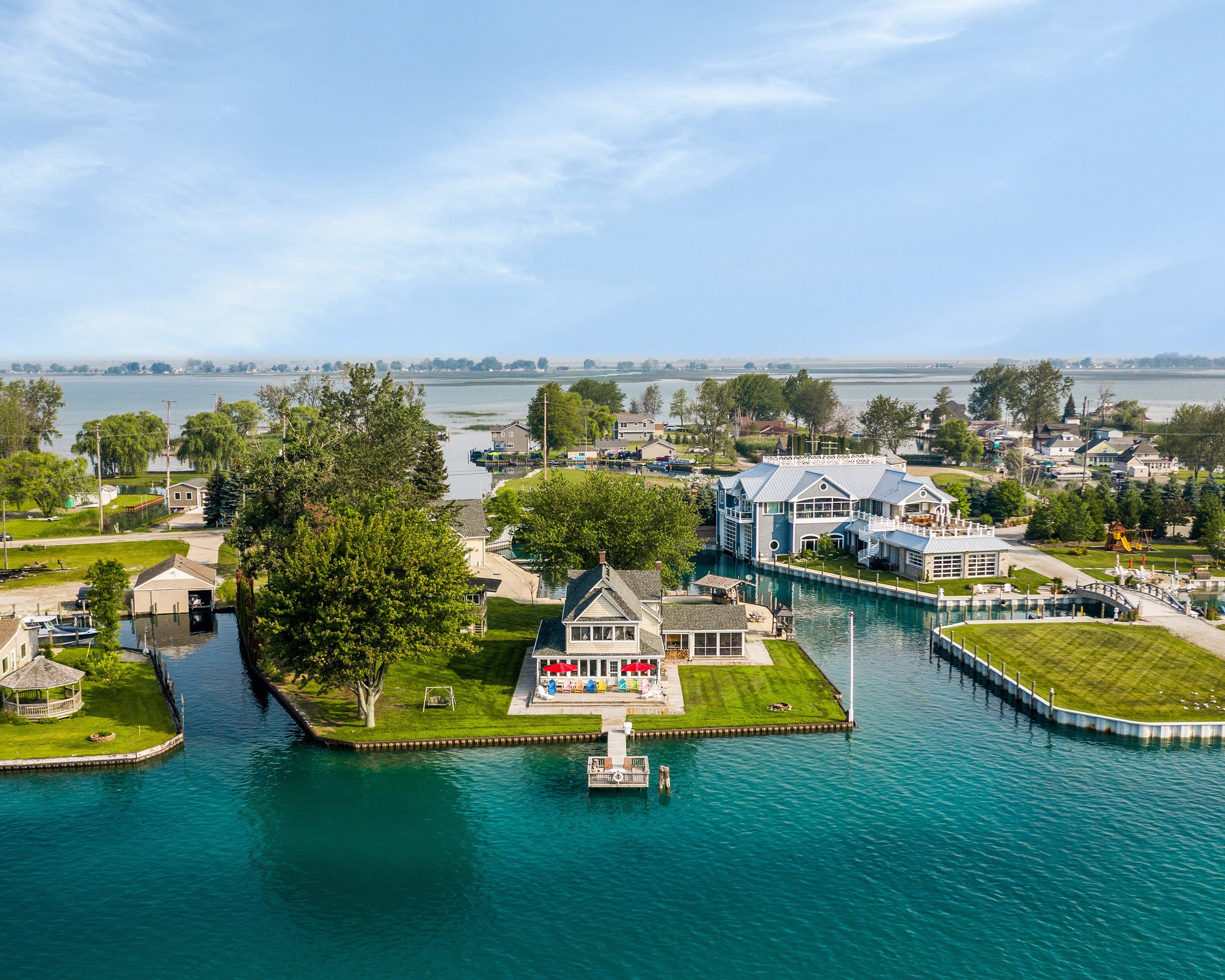
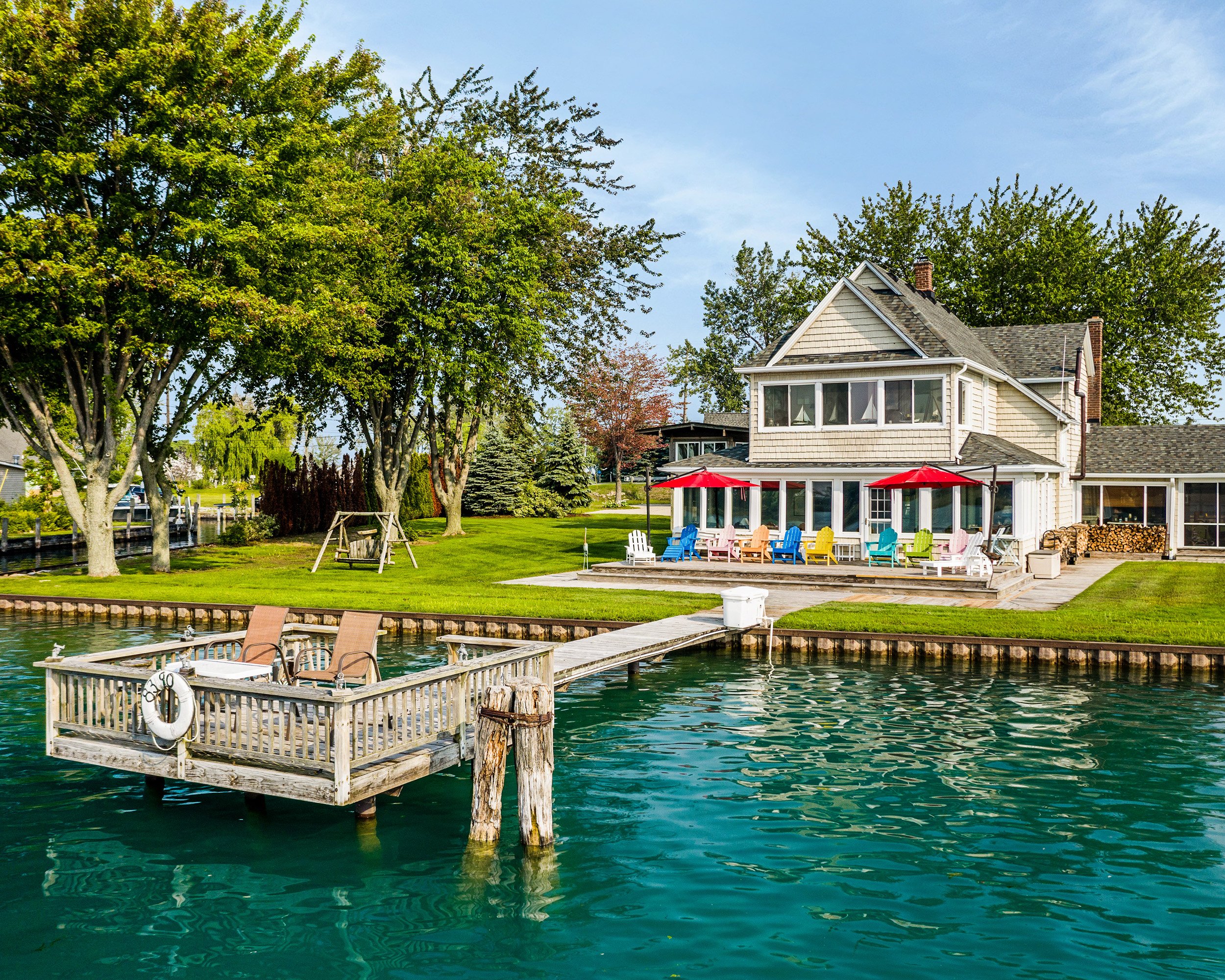
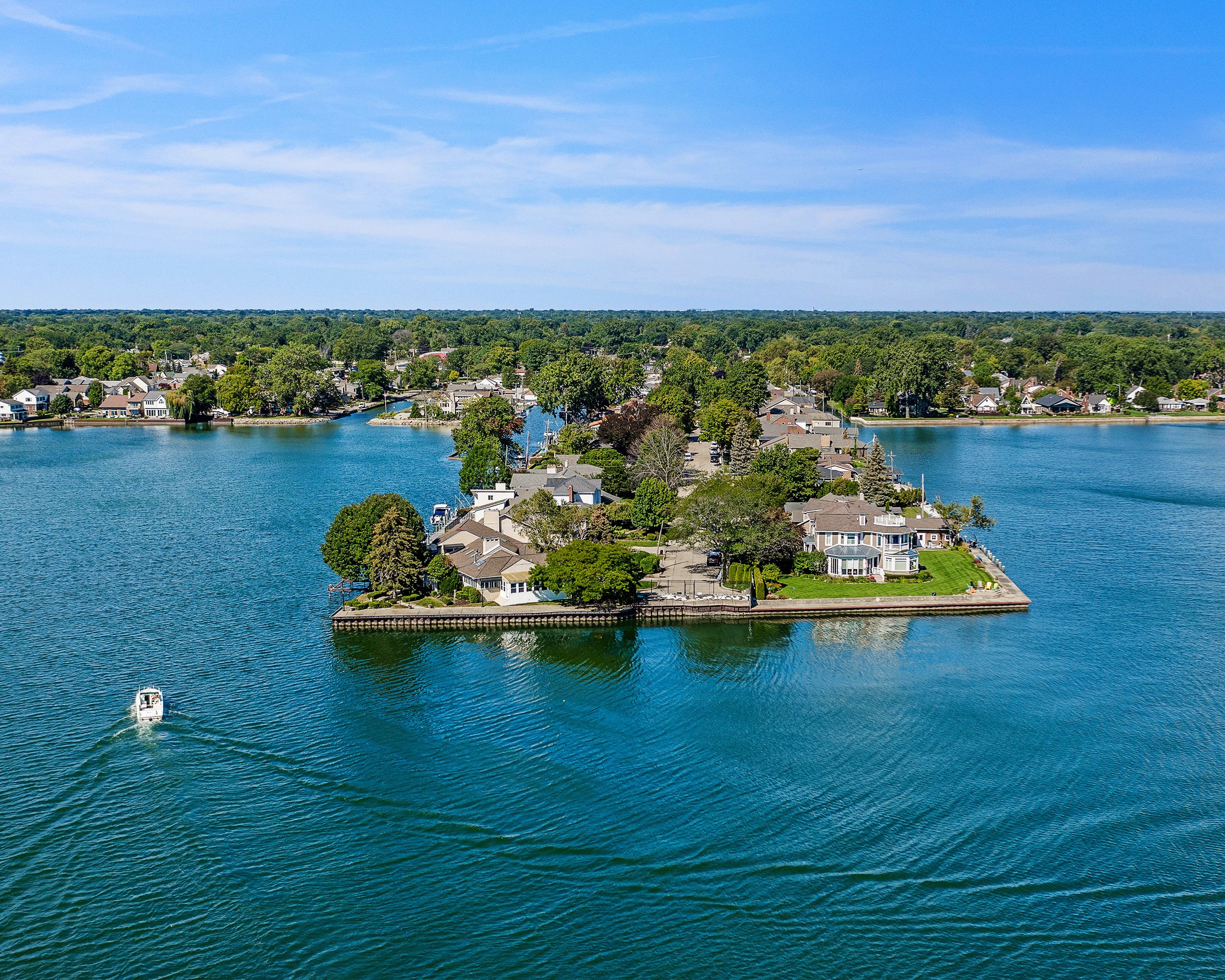
Elevate Luxury Listings With Aerial Photos
Let’s wrap this up with one more scenario where drone is helpful - luxury homes. Large estates often have large yards, and multiple areas of interest - pools, outdoor gathering areas, out buildings, etc. A few aerial shots can really give a buyer a lot of information about how the outdoor living space is arranged. It also can provide you with an interesting, graphic top-down pool shot. If the home has a separate wing, an aerial shot can really help buyers envision the layout and make sense of the interior photos better as well. And with residences of this caliber, privacy is also a concern, so an aerial view can provide important information about proximity to neighbors, and how the landscaping enhances the home’s privacy.
This home has multiple wings, and outdoor seating areas as well as a pool and dock. A top-down shot like this really helps a buyer understand where things are situated, and shows off the mature trees and privacy landscaping.
Summary: Best Case Uses for Drone in Real Estate
Homes that are taller than average - townhouses, homes perched on a hill, high rise condos, homes with more than 2 stories, or cathedral ceilings all benefit from drone.
Large acreages, especially those with outbuildings or multiple points of interest require drone.
Problem solving: If you need to downplay a front yard or emphasize a backyard, drone will help you be strategic and showcase the best features of a listing.
Waterfront homes absolutely benefit from aerial images, and it’s not just limited to images shot from a high elevation, often getting low over the water can result in especially pleasing images to show off structures like docks and boathouses.
Luxury homes often need drone to really capture all the special features about the property. Aerial photography helps raise the over all production quality of the listing presentation, and is something luxury sellers expect.
When you consider these points, it starts to make sense why many agents just add drone to all their listings. And many of these benefits only require a few images, so the Lite Aerial package is a really great way to get all the benefits of drone photography while keeping your marketing budget in check.
If you’re interested in adding drone photography to your real estate marketing kit, it’s as easy as selecting the “Reach for the Skies” package when booking a photography shoot with us. All of our drone operators are Part 107 FAA Certified, meaning you are protected from any legal liability. But more importantly for the final results, our drone operators are all photographers first. And that makes a difference. This post hopefully gives you some appreciation for how much care and thought we put into our drone photography work. It’s not as simple as just getting a camera in the sky, and in fact, I think an eye for composition becomes even more crucial when there’s less limitations on where the camera can be. A lot of our clients tell us they didn’t realize what a difference drone photography could make, or they didn’t think they could benefit from it until they tried it, especially if they had past experience with other vendors. Our team was carefully chosen because they have an eye for this stuff.
If you’d like to book a Reach for the Skies package, you can access our booking page by clicking here. I hope this post will make it easier to explain the benefits of drone photography when you’re meeting with sellers. If you have any questions, please leave us a comment below!












